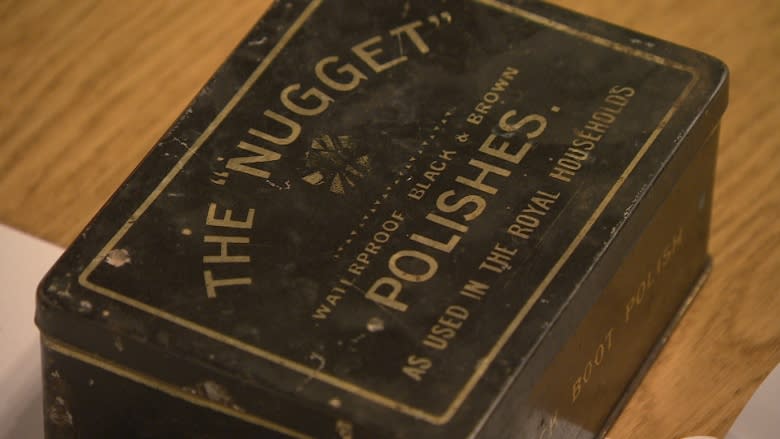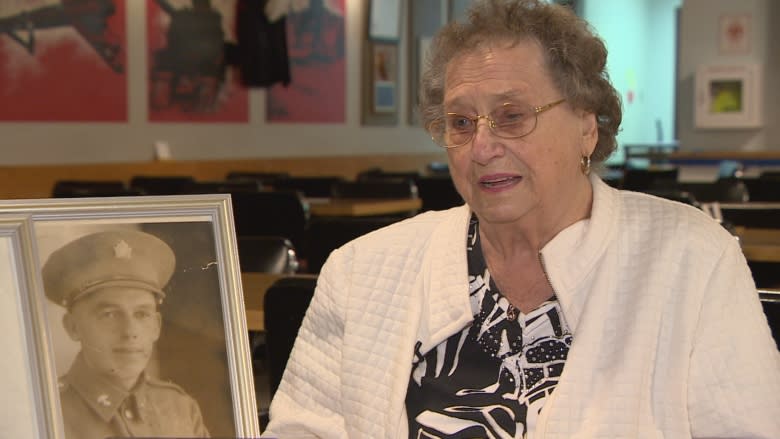'Box of miracles': Museum cracks case of mysterious negatives in shoe-polish box
The mystery behind a bundle of black-and-white photographs showing the earliest days of some Manitoba towns has been solved.
Well, a key part of it has been, anyway.
"I don't think it's done. As much as we've crossed a huge hurdle in it, now it's got a bunch of us doing a whole lot more homework," said Trevor Proutt, chair of the Pioneer Village Museum.
Late last year, the museum in the southern Manitoba town of Beausejour received a donation from a family whose mother had died. While they were going through her estate, they came across a tin shoe-polish box loaded with camera film negatives.
The museum, located in the small community about 50 kilometres east of Winnipeg, purchased a special scanner for old negatives to see what kind of story the box's contents would tell.
It revealed a time capsule of development and daily living in Beausejour, Lac du Bonnet and some other as-yet-unidentified towns in the early decades of the 20th century.
"There was everything — the bush camp, the town life, the road building. Everything," said Proutt.
But who took the pictures, and who was in them, was still a mystery. The family that donated the negatives had no idea.
"What happened in between there, that this box of negatives … ended up in the [donor] family's hands?" Proutt said.
"We don't know what that trail is and maybe we'll never know."
So the museum took to Facebook to search for answers, posting images as they were developed and asking for help. Staff members also took some of the photos around to local care homes but had little success.
Last week, one of those answers came from Cheryl Ward and her 90-year-old mom, Marge.
The two women picked up the the Discover Lac du Bonnet magazine. In it was an old photo of the Lac du Bonnet bridge — a photo they realized was taken by Marge's uncle, William Specht.
Cheryl saw Proutt's name listed with the picture and immediately began sending messages via email and social media.
Cheryl and Marge have since viewed many more photos from their family history — of Marge as a young girl, of Marge's aunts in the community of Ladywood, Man., of Specht playing the accordion, and several others of now-departed relatives — snapshots of bygone days, people and their stories.
"We stayed up until two in the morning looking at pictures. I can't believe it. I couldn't believe it. It's unbelievable," Marge said. "It's something else. I was just a kid — five, six years old."
Photographer's story develops
It's the story of Specht that is now, like his photos, beginning to develop. However, it's one that is all too brief, starting in April 1912 when he was born in Beausejour and ending abruptly just 29 years later.
"We've found out he was very much an entrepreneur, always looking for something that would better himself," Proutt said.
"Going through our negatives, we found him involved in so many things and dressed in many ways — in cook's clothes, in regular clothes, dressed-up."
"He used to take pictures of everybody and everything," Marge said. "And when we were kids he had a movie camera and he would set up a sheet on the wall and show us all the pictures."
In September 1939, Specht enlisted in the army and in December 1941 was a member of the Winnipeg Grenadiers stationed in Hong Kong. They expected to do little more than guard duty, helping to bolster the military presence in the remote British colony.
Instead, Hong Kong became the first place Canadians fought a land battle in the Second World War, when Japan attacked the colony as well as Pearl Harbour. The Canadians battled for a little more than two weeks but Britain surrendered Hong Kong on Christmas Day.
Almost 300 troops from Winnipeg and Québec City were killed, including Specht, who died on Dec. 19 and is buried on the island.
"But a bunch of us are now trying to figure out what William did between the time these photos were started and the time he went overseas," Proutt said.
"There is rumour that he got married in the 1930s but they [Cheryl and Marge] don't know the wife's name. There is no paperwork to be found."
The shoe-polish box is not only a time capsule. It's Specht's legacy.
"William led an adventurous life. We hope to show you part of it," states a posting on the Pioneer Village Museum's Facebook page.
Cheryl and Marge are doing what they can to help Proutt fill in the gaps in Specht's life story and fully expect more characters to emerge.
"Mrs. Ward has now started us on the journey to putting names to faces. Some of the family names that have come from the conversation have been Hudyma, Kapchinski, Hildebrand, Trombo and Burzminski," the museum's Facebook page says.
"Over the next couple of weeks and months we will post updates on images that tell us more about Mr. Specht, his family and his travels.
But there are many people in the photos who neither Cheryl nor Marge recognize. So who are they?
Marge hopes other families will identify loved ones and be able to dust off old memories like she has — to tell the stories of those who helped settle the rural areas of a young Canada, which is now set to celebrate its 150th birthday.
She is thankful Proutt has given her that opportunity.
"I think he's doing wonderful work. I can't believe it," she said.
"It's the box of miracles. It is, really."



